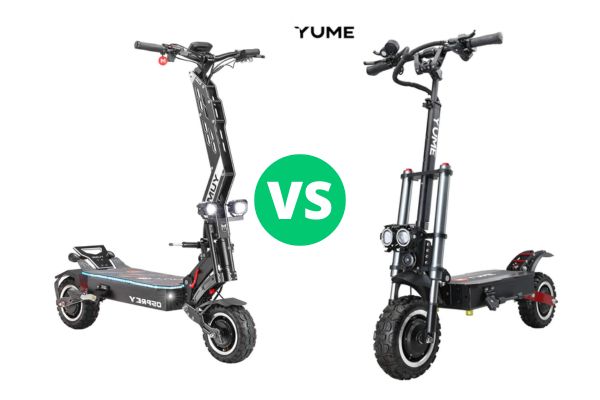Yume is well known for electric scooters that offer powerful specs at affordable prices. Two of their most popular models, the Yume Osprey and the Yume Y11+, present a compelling choice for riders. The Osprey is the newer, more advanced option, while the Y11+ is an older but still powerful and more budget-friendly machine.
The Osprey has a 72V power system and dual 3500W motors. It’s built for top-tier performance, with options like a Samsung battery and adjustable hydraulic suspension. On the other hand, the Y11+ relies on a 60V system and 3000W motors. It’s less refined but still very fast and much cheaper.
But this decision isn’t just about power or price. Yume scooters often have build quality issues, and many users report problems like faulty wiring or loose components. Owning one often means being ready to fix things yourself. This article breaks down all the key differences and offers clear advice for different types of riders.
YUME Osprey vs Y11+ Plus: Head-to-Head Technical Specification Matrix
Let’s start by comparing the raw numbers behind these two scooters. This table gives a side-by-side view of everything from speed and battery to features and pricing.
| Metric | Yume Osprey | Yume Y11+ |
| Standard Battery Price | $2,299 | $1,399 – $1,410 |
| Premium Battery Price | $2,849 | Not available |
| Motor Power (Nominal) | 2×3500W (7000W total) | 2×3000W (6000W total) |
| System Voltage | 72V | 60V |
| Top Speed | Up to 60 MPH | Up to 50 MPH |
| Hill Climbing Grade | 35-45° | 35-40° |
| Battery Capacity | 36Ah / 40Ah | 31.5Ah |
| Battery Type | EV-grade / Samsung 21700 | Generic 21700 |
| Total Energy (Wh) | 2592Wh / 2880Wh | 1890Wh |
| Charging Time | 6–7 hours (dual) | 6–8 hours (dual) |
| Range | Up to 100 miles | 50–60 miles |
| Suspension | Adjustable Hydraulic (Front & Rear) | Oil-dampened fork, spring shocks |
| Brakes | 160mm Hydraulic + E-brake | 140mm Hydraulic + E-brake |
| Tires | 11 x 3.95” Tubeless | 11 x 4” Tubeless |
| Weight | 123 lbs | 105–110 lbs |
| Max Load | 330 lbs | 330 lbs |
| Display | Color LCD | Color LCD |
| Security | NFC Card Lock | NFC Card Lock |
| App Connectivity | Yes | Yes |
| Lighting | Dual LEDs, turn signals, brake, horn | Angel Eyes, side lights, turn signals, horn |
| IP Rating | IP54 | IP54 |
Powertrain and Performance Dynamics
The biggest difference between these two scooters comes from their electrical setup. The Osprey uses a more powerful 72V system, while the Y11+ sticks with the standard 60V. That higher voltage helps the Osprey hit faster speeds and stay cooler during long rides.
The Osprey’s 7000W of motor power (with a 10,080W peak) gives it more acceleration and speed than the Y11+’s 6000W setup. The smoother sine-wave controllers on both models help with throttle response and make riding feel controlled.
The Osprey can reach up to 60 MPH, and users report it gets close to that in real-world rides. The Y11+ maxes out around 50–52 MPH. While that’s still extremely fast, the Osprey offers better performance at high speeds, especially during long hill climbs or repeated acceleration.
Also, the 72V system runs more efficiently by using less current, which reduces heat. This makes the Osprey better for aggressive riders who push their scooters hard. Its display even includes a heat protection warning, something the Y11+ lacks.
Endurance and Energy Systems: A Tale of Two Batteries
Battery quality and range matter just as much as speed. The Osprey wins again here, offering a premium 40Ah Samsung battery that delivers up to 100 miles of range. Even the standard version gives you 75 miles. The Y11+ only has a 31.5Ah battery, and its range tops out at about 60 miles.
But the real story isn’t just about size. The Y11+ battery is made from generic cells labeled “Automotive 21700,” which doesn’t say much about quality. The Osprey’s premium option uses verified Samsung cells, which are known for safety and reliability. This is a big selling point, especially considering the brand’s history with poor battery performance.
Both models support dual chargers, which helps shorten the long charging time. Still, the Osprey’s higher energy capacity means it will take slightly longer to charge even with two adapters.
Chassis, Suspension, and Ride Mechanics
Ride comfort and control depend on the frame and suspension. Both scooters use tubeless 11-inch tires, which offer a strong grip and are easier to repair in case of punctures. This helps with stability, especially at higher speeds.
The Y11+ has a decent suspension setup with front oil-dampened forks and rear spring shocks. But it lacks fine-tuning. In contrast, the Osprey includes fully adjustable hydraulic suspension. This allows riders to customize the stiffness and rebound based on their weight, terrain, and riding style.
This upgrade becomes more important when you consider the Osprey’s 123-lb weight. That added mass needs a stronger suspension to maintain control at 60 MPH. The Y11+, while lighter at around 105–110 lbs, doesn’t have the same level of stability. Some users even say it feels “shaky” at top speed.
Braking, Safety, and Illumination Systems
High speeds require strong brakes. Both scooters use ZOOM hydraulic disc brakes with electronic assist. But again, the Osprey stands out by using larger 160mm rotors, while the Y11+ uses smaller 140mm ones.
Larger rotors provide more braking force and better heat control. This is crucial when riding fast or down long hills. The Y11+ does include ventilated discs to help with cooling, but they still don’t match the stopping power of the Osprey’s setup.
Lighting is where the Y11+ has an edge. Its “Angel Eyes” headlights and glowing side deck lights make it highly visible at night. The Osprey also includes dual front lights, signals, and a horn, but its design focuses more on forward visibility than full 360-degree awareness.
So, the Osprey has better stopping power, while the Y11+ offers better nighttime visibility from all angles.
Rider Interface and Onboard Technology
Both scooters come with a long list of smart features. You get a large color LCD screen showing speed, battery level, mode, and other ride stats. Both offer app connectivity for iOS and Android, allowing you to adjust settings or lock the scooter remotely.
Each also includes NFC card-based locking for added security. And both include thumb and trigger throttle options in the box so riders can pick their preferred control style.
This spec list is impressive for the price. But there’s a catch: many users report that these features don’t always work as expected. Problems like faulty displays, non-working horns, or wires snapping due to poor routing are common.
That means every extra feature is also a potential failure point. Yume adds great tech, but doesn’t always deliver the build quality to match.
The Yume Conundrum: Build Quality, Reliability, and Ownership
Yume scooters offer amazing performance and features for the price. But there’s a downside. Many users say build quality is inconsistent, and the scooters often arrive with issues.
Some have received units with broken lights, loose bolts, or even damaged parts inside the box. Others found that critical systems like brakes or the suspension weren’t properly secured.
The biggest issue is that these scooters often require mechanical knowledge to fix. Riders are expected to tighten bolts, inspect wires, and test every system before riding. For experienced tinkerers, this isn’t a problem. But for casual users, it’s a major hurdle.
Customer service is another weak spot. Yume offers a short warranty,six months for the scooter, and a year for wear parts. Many buyers report that support is slow or unhelpful, especially if you bought through a third-party seller.
If you’re the type of person who prefers to ride instead of fix, Yume scooters might frustrate you. But if you enjoy tweaking machines and solving problems, you might love the hands-on aspect of ownership.
Final Verdict and Rider Profile Recommendations
Choosing between the Osprey and Y11+ depends on more than just performance. It comes down to your budget, riding goals, and how comfortable you are with fixing things.
Profile 1: The Performance-Driven Enthusiast
You want the best of the best: speed, range, and control. You don’t mind paying more for premium features, and you know how to handle a powerful scooter.
Recommendation: Go with the Yume Osprey with the Samsung battery. It’s faster, has better suspension, more range, and higher-quality components. This is Yume’s top-tier offering and is worth it for serious riders.
Profile 2: The High-Value Power Seeker
You want serious speed on a tight budget. You don’t mind a few issues if it means saving hundreds of dollars. You’re handy with tools and ready to tune and maintain your scooter.
Recommendation: The Y11+ is the best bang-for-the-buck option if you’re ready to deal with quirks. You must inspect it carefully out of the box and be prepared for small repairs or upgrades.
Profile 3: The Risk-Averse Commuter
You want a reliable ride with no surprises. You’d rather pay more for something that just works and don’t want to deal with tools or customer support nightmares.
Recommendation: Neither the Osprey nor the Y11+ is right for you. Consider brands like Segway, Apollo, or NAMI instead. They offer fewer headaches and more reliable support.
Conclusion
The Yume Osprey and Yume Y11+ are both capable of delivering thrilling rides. The Osprey is the newer, faster, and more refined option with features and performance that rival scooters costing thousands more. The Y11+ remains a strong performer at a more affordable price, offering nearly as much power with only a few trade-offs.
But Yume’s biggest flaw isn’t in design, it’s in quality control. Both scooters often arrive with minor (or major) issues that the buyer has to fix. For experienced riders who enjoy hands-on projects, these machines offer exceptional value. For others, they could become a source of stress and disappointment.
If you want to go fast and you’re not afraid to get your hands dirty, Yume scooters are hard to beat. But if you just want a scooter that works out of the box, look elsewhere. In the end, buying a Yume is not just a purchase; it’s a project.




